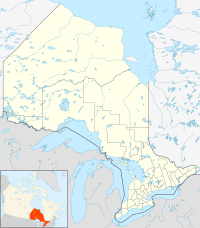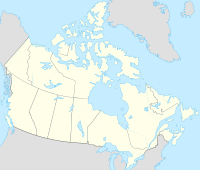Cat Lake First Nation facts for kids
Quick facts for kids
Cat Lake 63C
|
|
|---|---|
| Cat Lake Indian Reserve No. 63C | |
| Country | Canada |
| Province | Ontario |
| District | Kenora |
| First Nation | Cat Lake |
| Area | |
| • Land | 17.04 km2 (6.58 sq mi) |
| Elevation | 404 m (1,325 ft) |
| Population
(2021)
|
|
| • Total | 651 |
| • Density | 38.1/km2 (99/sq mi) |
The Cat Lake First Nation is an Ojibway First Nation community. It is located in northwestern Ontario, Canada. The community is on the north shore of Cat Lake. It is about 180 kilometres northwest of Sioux Lookout.
As of 2021, there were 651 people registered with the Cat Lake First Nation. The community is kept safe by the Nishnawbe-Aski Police Service. This police service focuses on Aboriginal communities.
Currently, the Cat Lake First Nation is dealing with a serious issue. Many homes have dangerous levels of black mould. To help fix this, the community reached an agreement with the Canadian government. In March 2019, they agreed on $12.8 million to solve this problem.
Contents
History of Cat Lake First Nation
The people of Cat Lake First Nation call themselves Bizhiw-zaaga'iganiwininiwag. This means "Men of Wild-cat Lake." Another name they use is Bizhiw-zaaga'iganiing Nitam Anishinaabeg. This means "The First Nation at Wild-cat Lake." The "wild-cat" they refer to is the Canada lynx.
The community of Cat Lake started as a trading post. The Hudson's Bay Company set it up in 1788. Later, it was part of the Osnaburgh Band of Ojibwe. The Cat Lake First Nation reserve was officially created on June 22, 1970.
The Cat Lake reserve is part of the land described in Treaty 9. This agreement is also known as the James Bay Treaty of 1905. The reserve was first 218 hectares in size. In 2003, it grew to 1771 hectares. This happened under a Canadian government policy. The First Nation has its own reserve called Cat Lake 63C. The community of Cat Lake, Ontario is located within this reserve.
The Cat Lake First Nation keeps strong connections with the Mishkeegogamang First Nation.
How Cat Lake First Nation is Governed
The Cat Lake First Nation is led by elected officials. These include a Chief, a Deputy Chief, and four Councillors. The current Chief is Russell Wesley. Matthew Keewaykapow is the Deputy Chief. Abraham Keesickquayash is the Head Councillor. The other Councillors are Irene Gray-Oombash, Gordina D. Oombash, and Allen Sr Oombash.
The council is part of the Windigo First Nations Council. This council helps different First Nations in the region. The Windigo First Nations Council is also part of a larger group. This group is called the Nishnawbe Aski Nation. It represents many First Nations in northwestern Ontario.
Past Governance Systems
In the past, the Cat Lake community used a system called the doodem-system. This system was based on family clans. Hereditary chiefs and councils led the community. However, this traditional way of governing changed. It was affected by Treaty 9 in 1905. Later, the Indian Act brought in new leaders from other areas. These leaders became chiefs for the Cat Lake First Nation.
Getting to Cat Lake
You can fly to Cat Lake Airport. North Star Air and Slate Falls Airways have daily flights. During the winter, you can also travel by winter/ice road. These roads connect Cat Lake from Pickle Lake, Ontario. This journey usually takes about 4 to 5 hours.



